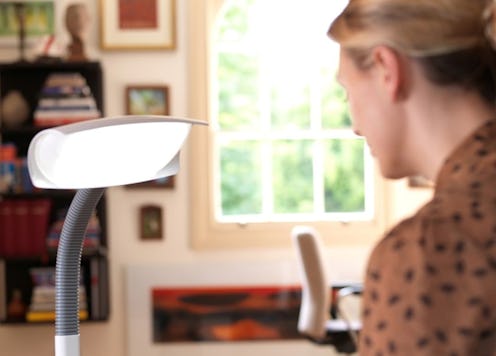Life
SAD Light Therapy Could Be Futile If You're Not Combining It With This One Thing

Seasonal affective disorder, or SAD, is a bit of a weird one. No one is entirely sure why some people suffer from feelings of depression during certain seasons and there is no definitive way to "cure" people diagnosed with SAD. Over the past couple of years, one particular treatment method has gained popularity. Light therapy, which involves sitting near a light box for a set period of time every day, is regularly touted as a way to improve the disorder. But does SAD light therapy actually work?
According to the NHS, SAD is a form of depression that most often appears during the winter months. Symptoms include things like a constant low mood, a lack of energy and interest in usual activities, and a tendency to sleep for longer than normal. Medical experts believe that being exposed to less sunlight, as is common during winter, may be the cause for the condition.
There are several reasons that may explain why. The NHS states that less sunlight could affect the function of part of the brain called the hypothalamus. This may lead to increased production of melatonin (a hormone that leads to feelings of tiredness), reduced production of serotonin (a hormone that affects things like appetite and mood), and an impact on the rhythm of the body's internal clock which dictates when you wake up and when you go to sleep.
Treatment for SAD has so far typically involved things like cognitive behavioural therapy (CBT), antidepressant medication, getting outside as much as possible, and, of course, light therapy. It is the latter option that many SAD sufferers seek out themselves.
Light therapy is the process of exposing yourself to a unique kind of lamp called a light box. It emits incredibly bright light that is designed to mimic natural sunlight, hopefully encouraging the brain to produce more serotonin and less melatonin. The time that you should sit next to the light box depends on the lamp that you choose but most people sit for around 30 minutes every morning, reports the University of British Columbia.
The effectiveness of light therapy is still being debated. Although it can be recommended to you by a GP, the National Institute of Mental Health states that almost half of people with SAD who only use light therapy will not see an improvement in their symptoms. A 2004 study published in the Journal of Affective Disorders found that more promising and long-term results tend to show when light therapy is combined with another form of treatment like CBT. Any improvement in symptoms may take a week to reveal themselves, according to an American Journal of Psychiatry study.
Light therapy may not work well alone, but that hasn't stopped many people with SAD from using it. If you'd like to try the method, it's important to remember that you shouldn't look directly into the light as this could cause damage to your eyes. Instead, place the lamp somewhere in your peripheral vision while you're working, reading, or watching TV. You may experience some side effects such as headaches, tiredness, blurred vision, or issues with sleeping. Most of these can be remedied by reducing the length of time you use the light box, sitting further away from it, and by using it first thing in the morning, rather than late at night.
If you buy a box with an intensity of 10,000 lux, the Mayo Clinic advises keeping it around 16 to 24 inches from your face and using it daily for around 20 to 30 minutes. Less intense light boxes may need to be used for longer. Lumie is just one brand that sells a range of light boxes to suit various lifestyles, but make sure you read the manufacturer's instructions and consult a doctor before beginning use. If you experience no adverse effects, you should keep using the lamp until spring arrives for maximum impact. Unfortunately, any improvements are likely to be short-term, so don't forget to haul your light box out next winter too.